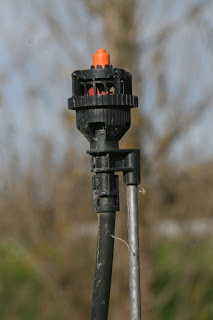Water use is a hot topic, both in terms of how much is used, but also what to do with the water afterwards. In fact, there is an internationally focussed meeting about this, specifically aimed at the wine industry, being held in Blenheim later this year (6th International Specialised Conference on Sustainable Viticulture: Winery Waste and Ecologic Impacts Management)
The Radio NZ article was brief, and I didn't hear the audio version of it, but I was intrigued, as figures like this are hard to interpret without knowing what goes into calculating it. So I wrote to Dr. Ranvir Singh, who is a Senior Lecturer in Environmental Hydrology and Soil Science at the Institute Of Natural Resources, Massey University to see if more information was available.
He very kindly replied and pointed me toward reports from the Water Footprint Network, who have published reports on global average values for water "use" for various crops and for animal farming. They were also the organisation behind the 2009 article, which quoted the values as coming from a report by Peter Gleick, who got his data (Table 19) from Waterfootprint.org.
So what is a water footprint? From the Water Footprint Network, it is "a spatially and temporally explicit indicator of direct and indirect water use of consumers and producers."
What does this mean? Similar in concept to the Ecological Footprint, and its sub-category the Carbon Footprint, the Water Footprint attempts to track all actual and "virtual" water use in the production and life of a item.
It's pretty easy to calculate the amount of water that is applied to grapevines, for example, and then set that against the tonnage of grapes harvested and the amount of wine subsequently made. And it's also reasonably straightforward to estimate the amount of water used in the winery through processing of the grapes into wine. There's even the opportunity to take into account the water used in the production of the labels, corks/caps, cardboard boxes etc. and add that to the total.
However, what is virtual water? Well gracious me, Wikipedia has an entry on that, too! The definition they quote there is “the volume of freshwater used to produce the product, measured at the place where the product was actually produced”
Getting back to our 109L per glass, that equates to about 870L of water per litre of wine. Let's look at what the vine contributes to that total.
Grapevines can typically use a couple of litres of water per day during the peak of the growing season, but use less in the Spring and Autumn as the temperatures decrease. So to allow some fudge-factor room, figure maybe 5 months of using 2L per day on average (either water in the soil or water applied through rain or irrigation). That's about 360L per season for the vine.
The amount of fruit a vine will produce varies a lot, but if we look at a typical Sauvignon blanc vine it might produce 4.5kg of fruit (this value varies a lot with vine spacing and other factors, but let's keep it simple...). In the winery this will probably equate to almost 3 litres of juice, which most likely will turn into about 2.9L of wine. So the vine itself is using about 124L of water to produce a litre of wine.
So that's about 14% of the total suggested by the report. The other 76% must come about from the winemaking process, packaging and other items used during the growing of the grapes and production of the wine.
Flood irrigation has a low capital cost to install, but is not suited to all areas, and quite a bit of water can be lost to evaporation, rather than getting to the vine roots.
However, some studies suggest that daily vine water usage can be upwards of 60 litres per day (e.g. here)! Yes, this is not the average over a season, but in a dry area with vines having a high crop load, the daily average might be quite a bit higher. All of a sudden, the vine is contributing a lot more to the total virtual water use, maybe doubling, tripling the value, or even more.
In-line drippers deliver the water to vines much more efficiently than flood irrigation
So what should we make of all this? With any model system, such as what they are doing with the water use studies, there are a lot of assumptions that need to be made - if there weren't the models would be far too complex to actually use. We've demonstrated with relatively simple calculations that there can be wide variation in the final number depending on the numbers going in.
So taking a value you might hear somewhere doesn't really mean an awful lot until you start investigating what went into the calculation of that number, and understanding how it comes about.
That is, with thy wine, take a grain of salt.... :-)
Here are some links of potential interest on the topic of water use:
Sonoma Wine Company, Graton Facility - A winery that was successful in reducing their water use
New Recycling Technology Turns Winery into Water Saver
A winery re-using water that has come from the winery
Wine Business Monthly article on winery water use
Sustainable Farming Fund project looking at benchmarking water use in the vineyard
Water use efficiency of table and wine grapes in Western Cape






